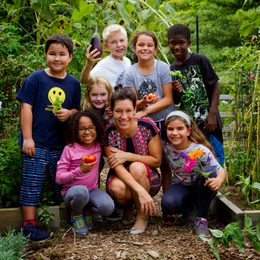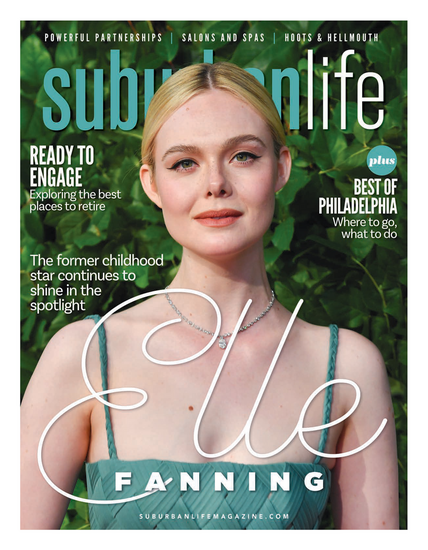
The Lower School campus of Friends’ Central School in Wynnewood is an incubator, of sorts. Here, every student enters an environment designed to shape him or her into a lifelong learner capable of higher-level thinking, as well as a compassionate, respectful person who strives to make the world a more peaceful place. Students also discover a safe place rich with new experiences that foster deep, lasting connections to the world around them.
It also enables them to have a lot of fun in the process.
Here, students’ days are filled with joyful and engaging activities, and the teachers have almost as much fun as the children do. This is due in part to the fact that the lower school has embraced an educational approach known as experiential learning, wherein students develop knowledge, skills and values from direct experiences both within and outside of a traditional academic setting. At Friends’ Central Lower School, this often means spending time outdoors, throughout its idyllic 18-acre campus, where teachers enjoy tremendous freedom in how they impart lessons for everything from the sciences and mathematics to history and the arts.
“So many people are talking about integrated learning among different disciplines, especially with kids growing up in such a connected world,” says Kelly Bird Pierre, who recently began her second year as principal of the lower school. “That doesn’t make sense if you are doing it in isolation. We want our students to be out in the world, which allows them to go deeper and immerse themselves in new experiences. With science, for example, students are not just learning about the life cycle of a frog, but they’re seeing that life cycle happen in the pond we have right on our own campus.”
This engaging approach jibes well with the school’s Quaker testimonies of simplicity, peace, integrity, community, equality and stewardship. An onsite garden, which teachers and students tend together, is a fine example of the school’s commitment to stewardship and sustainability. The space serves as a vegetable garden, fruit garden, butterfly garden and more. By spending time here—digging in the dirt, planting seeds, harvesting healthful fruits and vegetables for use in the school cafeteria—a student’s learning experience shifts from an abstract idea to a joyful event, according to Ginger Fifer, lower school assistant principal, who taught at Friends’ Central for 25 years prior to joining the administration.
“Students are not just learning about making an impact; they’re actually living it and able to see it,” she says. “Today, all the roasted potatoes on the menu [in the cafeteria] were from our garden, as were the vegetables in the cucumber tomato salad, the herbs in the dressing and half of the cherry tomatoes. Last week it was butternut squash and romaine lettuce. We also have fresh flowers all around the building, and the children know they had a hand in planting them.
“We have a real commitment to ‘skill and drill,’ because kids need to know their multiplication tables,
but they're just some of the tools in the toolbox,” she continues. “We also want them to have the tools needed to do higher-level problem solving. Yes, it’s important to learn the basics, but it’s much more important to be able to apply the information in a meaningful way. We have very happy children here who love learning. These children are doing very serious academic work, and the experiential nature of it makes them very receptive to it.”
In recent years, the garden has been expanded to grow vegetables such as potatoes, peas and carrots, as well as fruits such as apples, pears and raspberries and flowers such as zinnias. The garden is largely the brainchild of Peter Grove, a beloved science teacher and advisor currently in his 29th year at Friends’ Central. He has also been instrumental in introducing a bird-observation area, multiple ponds and walking trails, as well as a suspension bridge.
“Not every teacher is going to come down and garden, but we have found that there are many who are attracted to the idea that the garden can support whatever they are teaching, whether it’s math, theater, history, music—there’s no limit to it,” says Grove. “The whole purpose of the garden is not just to grow vegetables for food; the children get a huge mound of self-confidence and ownership within the school community when they see all these things they helped make.
“Children love to work with their hands, and while that’s a lot of fun, the teaching process is important, and I’m also of the mind that a good product at the end is essential,” he continues. “Children can see they’ve made some ponds or helped build a suspension bridge, and that has a wonderful effect. … When they can see that they are the ones to have built the bridge, nailed the slats on the roof of the bird-observation area or used stumps to correct an erosion problem, it makes it all very meaningful.”
Grove has a number of projects he would like to accomplish this year, including the installation of bluebird boxes, the development of a new cookout area near the garden and irrigation-system improvements to capture rainwater coming off campus roofs. To push the garden to the next level, he has gained help from Tiffany Borsch and Sarah Taylor, both of whom are science teachers at the lower school.
“The outdoor spaces enhance what you do in the classroom,” says Borsch. “I see it as connecting kids to the outside and then layering the classroom science on top of it. … For the third graders, we’re talking about the watershed right now. We’re going to a nearby stream for ecology studies, and at the same time we’re talking about where water comes from and doing some self studies so they can see how much water they consume at home. The goal is to get them to make connections to what’s going on around them.”
“This is such a fun way to teach,” adds Taylor, who runs an extracurricular gardening club for interested lower school students. “The garden is a huge focus for the science department, but it’s in the minds and hearts of all the teachers here because it really engages the kids and brings lessons to life. They’re excited and it makes them want to learn more. It also ends up being more of a student-led endeavor; for students who might have more of a naturalistic bent but maybe are not as great in math, they can find a place where they feel like they are experts.”
Plans are in development to further expand the garden and other outdoor/experiential spaces, including for extended wintertime use. The innovations are coming indoors as well, as the school is preparing to renovate an on-campus carriage house and re-imagine the space as a Light Lab. The Light Lab will feature four hands-on “maker spaces”—two measuring 800 square feet, two spanning 500 square feet—for use in teaching the natural sciences, media/computing, fabrication and design, all to provide students with every opportunity to tap into his or her creativity. Construction is expected to begin late this year, with an opening date of sometime in 2016.
“We provide students with the space to take many different roads to success,” says Pierre. “There’s something very exciting about that. Our goal is to bring out the great potential inside every student, and that’s something you might not see in a more constrictive environment. We are nothing without everyone’s contributions; it makes us who we are.”
In everything it does, the lower school focuses on educating “the whole child,” as Fifer calls it, to create a healthy balance in all areas of a child’s development. This includes not only academic excellence but also a commitment to service and a healthy respect for others. The resulting atmosphere creates a strong sense of community that enables students to learn from one another. As Grove suggests, Friends’ Central is, above all, “a very human place.”
“My own children went there, and they had a wonderful experience,” he says. “Friends’ Central has more than its fair share of devoted, caring teachers whose lives are spent helping children learn and grow as individuals. They’re going all out for the children, and that’s what makes it such a wonderful place.”
Friends’ Central School
www.friendscentral.org
Lower School Campus
228 Old Gulph Road
Wynnewood, PA 19096
610-642-7575
Middle & Upper School Campus
1101 City Avenue
Wynnewood, PA 19096
610-649-7440
Photograph by Jody Robinson


